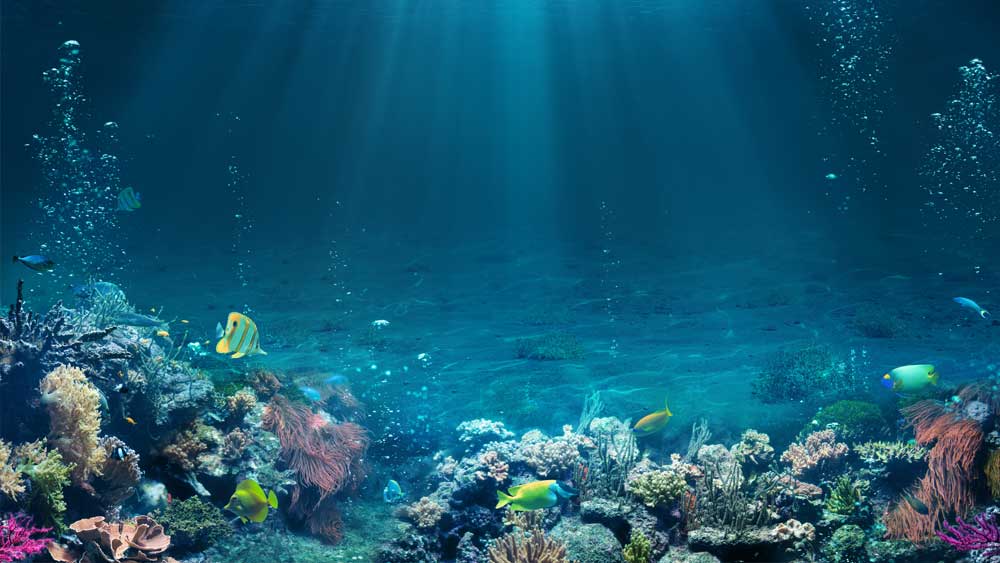A virus is a very tiny structure. In its simplest definition, a virus is some nucleic acid (either DNA or RNA) packed inside a protein coat. It is designed to replicate inside living cells. Not all viruses are bad, but the disease-causing ones such as COVID-19 get all the press coverage. Creation scientists believe viruses were created in the beginning and that many have undergone mutations (such as the flu virus) after the Curse.
Viruses are found everywhere, especially in the world’s oceans where their numbers can be astounding. In just 12 drops of surface seawater, there can be as many as 10 to 100 million per milliliter.1 Indeed, marine microorganisms (including viruses) make up about 70% of the oceanic biomass. All the tiny creatures together are called the marine microbiome.2 Biologists estimate marine viruses are in concentrations of approximately 3 billion per ounce of seawater. The carbon cycle is a critical part of Earth’s ecosystem and is the largest of all biochemical cycles. The microbial community plays an important part in the marine carbon cycle. It is an example of God’s design found in complex ecological interactions.
The oceans also have vast numbers of bacteria that are constantly reproducing in prodigious numbers. Their numbers would overwhelm the ocean in a relatively short time were it not for specially designed viruses called bacteriophages (or phages). Under a powerful electron microscope, many of the oceanic bacteria look rod-shaped, while the phages (called T-even or E. coli phages) look like tiny lunar landers with long spindly legs. Several dozen phages can cover a single bacterial cell. Bacteriophages are significantly smaller than these bacteria.
The phages are designed to land on the surface and inject their genetic material into the bacterial cell when the phage’s “legs” contract. Then the cellular machinery of the bacterium starts to produce more phages due to new instructions from the phage. In short time the bacterial cell breaks apart (lyses) releasing more T-even phages that go on to infect other oceanic bacteria. This is called the lytic cycle. In this way the levels of bacteria are controlled by these important phages (called femtoplankton).
There are also other kinds of microorganisms in the oceans called cyanobacteria (formerly called blue-green algae). This large and diverse group of bacteria contains the pigment chlorophyll and therefore can undergo the complex process of photosynthesis.3 Their vast numbers are also controlled by viruses called phycoviruses.
Taken together, we can see interactions of viruses with their hosts (bacteria, cyanobacteria, and even fish) in the marine ecosystem.4 They are all part of God’s grand design to keep the oceans healthy.
References
1. Garrison, T. and R. Ellis. 2016. Oceanography, 9th edition. National Geographic Learning, 399.
2. Sherwin, F. 2016. Applying design analysis to microbiome research. Acts & Facts. 45(2).
3. Sherwin, F. 2019. Photosynthesis: Clearly Designed from the Beginning. Creation Science Update. Posted on ICR.org August 13, 2019.
4. Middelboe, M. and C. Brussaard, C. 2017. Marine Viruses: Key Players in Marine Ecosystems. Viruses. 9 (10): 302.
*Mr. Sherwin is Research Associate is at ICR. He earned his master’s in zoology from the University of Northern Colorado.

An Ocean of Viruses
The Latest
Liberty and the Word of God
“And I will walk at liberty: for I seek thy precepts” (Psalm 119:45).
July 4th is called Independence Day here in our country because on...
July 2025 ICR Wallpaper
"These things I have spoken to you, that in Me you may have peace. In the world you will have tribulation; but be of good cheer, I have overcome...
Valued Longtime ICR Employee Mary Smith Retires
Mary Morris Smith, an employee of the Institute for Creation Research for many years, has retired. The second daughter of ICR founder Dr. Henry M. Morris...
Man of Science, Man of God: George Washington Carver
Who: George Washington Carver
What: Father of Modern Agriculture
When: 1864 or 1865 – January 5, 1943
Where: Diamond Grove,...
The Scopes Monkey Trial: A Battle of Worldviews
Rhea County Courthouse in Dayton, Tennessee, and its statue of William Jennings Bryan
Image credit: M. Mueller
The Scopes Monkey...
Long Non-Coding RNAs: The Unsung Heroes of the Genome
Evolutionary theory holds that all living things came about through random, natural processes. So conventional scientists believe the genome has developed...
Yosemite National Park, Part 1: Tiny Clues of a Grand Picture
Yosemite National Park in California is a sure source of stunning scenery. It’s no wonder that American naturalist John Muir persuaded President...
From Inference to Theory: A Common Design Case Study
Without a doubt, humans, chimpanzees, and other organisms share similar features. An early explanation was that these features reflect similar designs...
Creation Kids: T. rex
by Michael Stamp and Susan Windsor*
You're never too young to be a creation scientist and explore our Creator's world. Kids, discover...
Entering By The Door
Recently, I hosted a visiting pastor from a large church at ICR’s Discovery Center. As I guided him through our Dallas museum, one conversation...

















